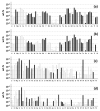Hybrid Ultra-Low-Radioactive Material for Protecting Dark Matter Detector from Background Neutrons
- PMID: 34279328
- PMCID: PMC8269799
- DOI: 10.3390/ma14133757
Hybrid Ultra-Low-Radioactive Material for Protecting Dark Matter Detector from Background Neutrons
Abstract
A laboratory technology for a new ultra-low background hybrid material (HM) which meets the requirements for neutron absorption with simultaneous neutron detection has been developed. The technology and hybrid material can be useful for future low background underground detectors designed to directly search for dark matter with liquid noble gases. The HM is based on a polymethylmethacrylate (PMMA) polymer matrix in which gadolinium nuclei are homogeneously distributed up to 1.5 wt% concentration in polymer slabs of 5 cm thickness. To determine the 65 impurity elements by the inductively coupled plasma mass-spectrometry (ICP-MS) technique in the Gd-based preparations in 100-0.01 ppb range, the corresponding method has been developed. Limits of determination (LD) of 0.011 ppb for uranium, and 0.016 ppb for thorium were achieved. An analysis of Gd raw materials showed that the lowest contents of U and Th (1.2-0.2 ppb) were detected in commercial Gd-based preparations. They were manufactured either from secondary raw materials (extraction phosphoric acid) or from mineral raw materials formed in sedimentary rocks (phosphogypsum). To produce the Gd-doped HM the commercial GdCl3 was purified and used for synthesis of low-background coordination compound, namely, acetylacetonate gadolinium (Gd(acac)3) with U/Th contents less than LD. When dissolving Gd(acac)3 in methylmethacrylate, the true solution was obtained and its further thermal polymerization allowed fabrication of the Gd-doped PMMA with ultra-low background.
Keywords: dark matter; gadolinium; hybrid material; inductively coupled plasma mass spectrometry; low-radioactivity; neutron background; polymethylmethacrylate; thorium; uranium.
Conflict of interest statement
The authors declare no conflict of interest.
Figures









References
-
- Empl A., Jasim R., Hungerford E., Mosteiro P. Study of Cosmogenic Neutron Backgrounds at LNGS. arXiv. 20121210.2708
-
- Westerdale S., Meyers P. Radiogenic neutron yield calculations for low-background experiments. Nucl. Instrum. Methods Phys. Res. Sect. A Accel. Spectrometers Detect. Assoc. Equip. 2017;875:57–64. doi: 10.1016/j.nima.2017.09.007. - DOI
-
- Agnes P., Agostino L., Albuquerque I., Alexander T., Alton A., Arisaka K., Back H., Baldin B., Biery K., Bonfini G., et al. The veto system of the DarkSide-50 experiment. J. Instrum. 2016;11:P03016. doi: 10.1088/1748-0221/11/03/P03016. - DOI
-
- Kikoin I.K. Tables of Physical Values. Handbook, Atomizdat; Moscow, Russia: 1976. 1008p
-
- Poehlmann D.M., Barker D., Chagani H., Cushman P., Heuermann G., Medved A., Rogers H.E., Schmitz R. Characterization of Gadolinium-Loaded Plastic Scintillator for Use as a Neutron Veto. arXiv. 20181812.11267v1
Grants and funding
LinkOut - more resources
Full Text Sources
Research Materials
Miscellaneous

